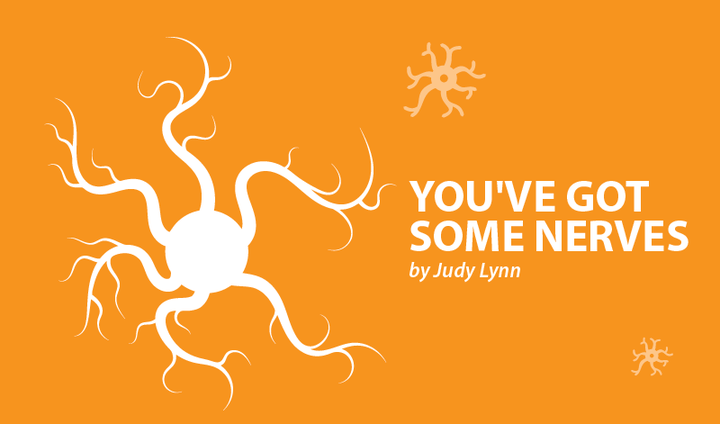Rolfing and MS: Bliss or Pain?


Invisible symptoms can create an isolating experience for people with MS. I recently was reminded of the power that lies in finding community and shared experience. Last month’s column discussed the chronic tightness and pain I experience. I then explored whether fascia may play a role in this discomfort.
A robust and encouraging discussion followed the column’s posting on Facebook. Fellow MS patients chimed in with an array of ideas, techniques, and treatments that have worked well (or not) for them. It was heartening to hear that the conversation simply helped many to feel less alone with a pain and discomfort they had struggled to describe to loved ones and healthcare providers. I’d like to use the next few columns to follow up on some of the themes and suggestions of this amazing MS community.
Massage therapy was mentioned frequently — sometimes covered by insurance, but more often not. A particular type of massage therapy, called Rolfing, was also discussed. Rolfing, named after it’s founder Ida P. Rolf, is designed specifically to work on our fascia, or connective tissue.
The Rolf Institute of Structural Integration provides certification and training for practitioners. The institute states, “Rolfing Structural Integration works on this web-like complex of connective tissues to release, realign, and balance the whole body, thus potentially resolving discomfort, reducing compensations and alleviating pain.” The short video on the webpage is worth the watch. People with MS are likely to develop weakness in parts of their body, which can lead to compensation by other muscles, which in turn can lead to a whole lot of out-of-whackness, if you ask me! I think that Rolfing sounds made for MS.
However, I have also heard anecdotally from friends who do not have MS that Rolfing is painful and it left them bruised as the practitioner “rearranged their muscles.” That poor choice of wording caused me to shy away from it. People seem to report everything from a sense of release and bliss to discomfort and pain.
The National MS Society talks about the use of massage therapy for patients with MS, and Rolfing is listed as one type of therapy. It does not appear that researchers have looked into Rolfing specifically for patients with MS. One study did look at the prescribed series of 10 Rolfing sessions for patients with cerebral palsy. The study found that “Rolfing can lead to improved performance in mildly affected patients because they possess the neurological capacity to make use of increased muscle mobility to avoid contractures. However, the increased muscle tightness which can occur probably outweighs any benefit which moderately or severely impaired patients may derive from treatment.”
I know that cerebral palsy and MS are different, but it seems possible that MS patients may experience similar results. In other words, if you get all loosened up and straightened out after your 10 sessions, but your MS spasticity remains (which it will, this isn’t a cure), then you may end up back in the same place. There is always a chance that something may make you feel worse — maybe too much poking and prodding will aggravate nerve pain or cause your spasticity to worsen.
Another study of healthy men found that a particular Rolfing practice resulted in a significant increase in parasympathetic tone, which “could explain why these techniques have been clinically successful in treating myofascial pain syndromes and other musculoskeletal dysfunctions. …” Connect that dot to a study that discusses how increased parasympathetic tone (via physical activity) “may be a strategy to reduce inflammation and prevent chronic disease,” and I have drawn an admittedly sketchy connecting line between Rolfing and MS that may be worth talking to your doctor or massage therapist about. MS management strategies seem to be five parts science and five parts art. As always, listen to your body and decide what’s right for you. If any of you give this a try, please let me know how it goes — bliss and unicorns, or pain and tears, or maybe a bit of both!
***
Note: Multiple Sclerosis News Today is strictly a news and information website about the disease. It does not provide medical advice, diagnosis, or treatment. This content is not intended to be a substitute for professional medical advice, diagnosis, or treatment. Always seek the advice of your physician or other qualified health provider with any questions you may have regarding a medical condition. Never disregard professional medical advice or delay in seeking it because of something you have read on this website. The opinions expressed in this column are not those of Multiple Sclerosis News Today or its parent company, Bionews Services, and are intended to spark discussion about issues pertaining to multiple sclerosis.







Connie Hyden
I've had RRMS for 10 yrs. I've been on many therapies, I've reacted to all of them. I recently stopped Tecfidera, it makes me nauseous. I've been in a trial and reacted my 3rd day in. I'm the only one out of many who reacts to everything.
Catherine Hair
I am the same. I could not tolerate Avonex and had high fevers with it
Copoxone caused very strong flushing and I believe as did the hospital ER an allergic reaction
Aubagio caused multiple severe infections. As did Tecfidera ( I became JCV positive and I became frightened). After that Rituxan again multiple infections
Penelope Silverstein
Hi Judy,
I was diagnosed with RRMS in 2012 & besides conventional treatment with copaxone and a year of steroid infusions to calm down and or halt my continuous active lesions. I set out to find and try any alternative treatments that could help. I changed my diet completely as well as adding regular massage therepy. I started with Swedish massage twice a week at our local massage school where I met an amazing Laotian woman who did Thai massage on me as she was taught to do by her grandmother. We continue our work together to this day, but as I improved I now only need to see her every other week though we do a 2-4 hour session each time. My MS encouraged her to learn more and she took studies in medical massage and is now liscenced in it. The kind of massage she does for me sounds like a cross between Thai massage, acupressure, deep tissue and some Rolfing. She works on me and concentrated on what seems to need it the most while always doing a whole body massage to help with muscle tightness & circulation. When I started work with her I had drop foot and weakness on my entire left side. I had a brace on my foot and needed assistance in walking any distances because of my imbalance and inability to lift my foot on my own and not trip. The change that has occurred for me over the years is staggering (no pun intended) but together we were able to clearly map the difference that occurred with my movement, balence, strength, & overall physical & mental well-being. The bodywork she does with me is in no way easy a lot of the time & we joke by saying “if it doesn’t hurt, it doesn’t help”... but now, though I still seem to have an occasional flair, usually triggered by either extreme stress or if I have physical trauma (I own a tattoo shop and have learned that large or intense body modification to my dismay, can kick off a flair) my symptoms I once thought I would have to live with forever are basically gone. I no longer need my brace or assistance walking. My balance is almost what it once was ( which says a lot because I was a gymnast ) I no longer suffer problems with my bladder & bowels, & have also noticed cognitive improvements. Because my diet change went hand in hand with when I started my massage therepy, it’s hard to pinpoint exactly what has done the most for me but I 100% believe at the very least, that massage is what helped me regain the use of my foot on the left side, as well as my balance & the reduction in overall pain. If our schedules get messed up and I go for over a month without seeing her (which has only happened 3 times in 5 years) I begin to have noticeably more discomfort & tightness in my muscles, & when I get work again it is vastly more uncomfortable. I have no intention to go longer to see what would happen if we discontinue this massage therapy. I know I am lucky to have had access to this kind of treatment & hope that my experience may help others to consider massage as a good & viable option for improvement in their current situation. If you would like to hear more about the kind of massage & the way we approached this kind of therapy, and our experience I would be glad to discuss it with you.
Judy Lynn
Thank you so much for sharing your story! That's good to hear that a long massage session works for you; others said they had to do short half hour segments. Just a reminder that we are all so individual and must persevere to find what works for us!
Suzanne Ireland
Hi Penelope!
I just read your post and it has given me such hope. I am still in the diagnosis phase - somewhere between ms and als... I would love to know more about your diet and the name and address of your massage/ Rolfer.
patti
hi i am also curious about your diet switch as mentioned in beginning.... ty
Linda Sawtelle
Hi Penolope - where do you live because I'd like to find a massage therapist nearby in the san francisco bay area that works with MS patients successfully
Felisa Holmberg Certified Rolfer of Structural Integration
Rolfing Structural Integration is not supposed to be painful and nor leave bruises. That is not how we are trained. We are trained to gently ask the tissue to release, not force it. We have to touch your pain to release it, but not cause pain.
Judy Lynn
Felisa- Thanks for that comment! Yes, everything I found on Rolfing stated it should not cause pain. It was the anecdotal stories where pain was mentioned. Perhaps it's a case of insufficiently trained therapists or a more likely situation- we don't know it was hurting until you "touch our pain", therefore we mistakenly describe it as Rolfing causing pain. Thanks again- I'm going to give it a try!
Lisaann Czarnowski
Hi Judy. Interesting article.I have never heard of rolfing before. However, I have gone to a massage place that uses the Tui Nga technique. I have had many back surgeties & when my sciatica started back up I gave it a try. It sounds similar to the rolfing,but instead actually works by opening up the channels that the painful nerve is being compressed at & the muscles causing that compression by their massage & manipulation & special herbal oils. I have to say my 1st time I was in tears.I left saying I would never do that again.Until about a 1/2hr or so later when all of a sudden I felt better than I had in an extremely long time. So I did go back but unfortunately finances don't allow me to go back like I should. They also utilize other techniques but I am not willing to try (cupping,scratching)
Catherine Hair
Can anyone tell me where there is a good Rolfing specialist. , that does not leave bruises, in Fairfield county, CT?
Laura
You can go to www.theIASI.org -The International Association of Structural Integrators,
to find practitioners of Rolfing and the many "spin-off" school graduates. Trained Rolfers have created a global variety of 20 Rolf-based training approaches.
The IASI schools offer Basic Training and Continuing Ed courses, and Board Certification for all practitioners of "Structural Integration", the first name that Dr.Rolf gave to her "Rolfing" process. My first experience of Rolfing was as a student's model in a Basic training class. My scoliosis (after a year of waitressing) was relieved immediately. After my 10sessions from a student, my next baby - 2nd of 3 - was born in 5 hours, 9lbs 10 ozs, hers was the "easiest" labor. (it's never easy, your results may vary!) Later I knew I had to train to be a Rolfer. As we say in trainings: "Thank You Dr. Rolf."
Laura
Hello Catherine I looked on www.TheIASI.net
for practitioners: none are listed under "Fairfield County"; by state there are 3 practitioners in CT, 2 in Greenwich and 1 in Sterling. You can learn about all three of them on the above web site for Structural Integrators (aka Rolf-based therapies). I hope you and the other people posting here find good help from good bodyworkers.
Chad Levesque
I have recently been diagnosed with m.s. and am currently recei ing no treatment from the medical system. I am taking lions mane and a combo of vitamins and minerals I discovered rolfing or it discovered me when I met my new neighbor a rolfer who started me on this part of my healing journey. So far I have found the results amazing and I agree the pain involved had to be found to be released. After my last session I danced all night at a rave something I wasn't sure I would ever do again. There is definately something to be said about scolding and m.s.
Laura
I'm glad to have found your web site. I've been a Certified RolferTM for over 20 years.
From 2000 thru 2005-ish I worked in a group practice including various massage therapies,
and Reiki, essential oils/Rainbow treatment, an acupuncturist, and me, the Rolfer.
For a couple of good years we offered a deep discount to members of the local Multiple Sclerosis Support Group. Our MS clients were glad to receive sessions in all these modalities.
(Btw there is a light-touch manual version of acupuncture called “AcuPressure”. It's also on your menu of resources, lots of online descriptions.)
It helped them reduce pain and to have a little bit more balance and coordination after their sessions with us. It was rewarding for us bodyworkers too – I missed it when the business was discontinued by the owner/manager who then had other issues to deal with. Later I was in other group practices but no organized program for MS clients. I'm in process of moving cross-continent, looking forward to my next practice.
About “PAIN” in bodywork: When you receive bodywork from a licensed professional, YOU ARE ALWAYS THE BOSS. If it doesn't feel right, say so. If your bodywork therapist disagrees, or tells you to “Count to ten to get through it” I encourage you to get up off the table and never go back to that bodyworker. Or, just say NO. When you are on my table, you are THE BOSS. When you are on any bodyworker's table, you are THE BOSS. As for the 50-year reputation of Rolfing being “too rough” please know that Rolfing Done Right never hurts. There is a wide spectrum of sensation, and the no-pain zone is what you can and should expect. Sometimes I explain it as:
“The Good Hurt is old pain coming out. Bad Hurt is new pain coming in.
You decide what's good for you and what's not. As Rolfers we strive to carefully get acquainted with the tight spots, and invite those tight spots to take a vacation, to re-think their fibrous job.”
My long-time regular clients for 15~20 years included runners, dancers, adult and teen-age athletes, construction professionals, and adults and children with scoliosis. Once I worked on a 3~week old baby with torticollis: the pressure level I use with such a fragile angel is like butterfly wings.
That is to say, we have “a lot of tools in the toolbox,” as one of my Rolf Institute instructors told us. All The Best To You
Marla Solarski
I’m a massage therapist in the Bucks County, Pa area. I have worked with many issues clients present with, including MS.
I couldn’t agree more with Laura in her above comments.
Patients need to speak up when something is making them uncomfortable. Massage is about communication. Everyone we work with comes with a unique set of issues. A good therapists most valuable tool is the ability to listen and formulate a productive plan for that session, as it may be completely different from a previous/ future session. Respect is key!
Tammy Mendoza
I just had session 4 of Rolfing today. Have had zero passion/discomfort. It has already helped a severe pain that I've had for 3 years and no Dr. Not chiropractor could help with. Can't wait to see the end result. It has also helped my balance ( got worse before it got better)
Highly recommend. Diagnosed RRMS in 2015, treat naturally through diet and supplements. Reacted to all treatments I tried.